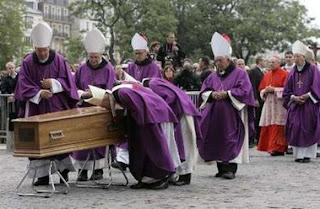 A new study is out on the American Catholic Church — or, more specifically, Catholics who are American — and Andrew Greeley has donned his sociologist cap to ruminate on it in the current issue of America.
A new study is out on the American Catholic Church — or, more specifically, Catholics who are American — and Andrew Greeley has donned his sociologist cap to ruminate on it in the current issue of America.
The study is called “American Catholics Today: New Realities of Their Faith and Their Church,” and it was compiled by Dean Hoge of Catholic University. As Fr. Greeley describes it:
Professor Hoge composed a list of 12 “elements” of Catholicism and asked how important each was (ranging from “very important” to “not too important at all”). The elements ran from “helping the poor” to “celibate male clergy” and included such matters as “devotion to Mary the Mother of Jesus” and “teachings in opposition to abortion.” These findings are gathered in his new book, American Catholics Today…
[snip]
While the percentages of respondents saying “very important” may differ in different contexts, the top four items in all the studies are the same. According to “American Catholics Today” … more than three-quarters of the respondents said that helping the poor, the resurrection of Jesus from the dead, the sacraments (in some versions it was “the Real Presence of Jesus in the Eucharist”), and Mary the Mother of Jesus were “very important.” At the bottom of the list was abortion, teaching authority, death penalty and celibate male clergy.
[snip]
The Catholic respondents knew in each of these studies what is absolutely essential in their religion–Jesus risen, the poor, Mary and the sacraments. After a couple of thousand years of turbulent history, they still get it “spot on,” as our English colleagues would say. This is no mean achievement, especially in these years of “polarization” (which actually doesn’t exist) and sexual abuse crises.
Fr. Greeley then goes on to address a couple of other issues that are sure to raise eyebrows — and blood pressures:
In another question, the researchers asked about “boundary” issues: what kind of behavior marked one as beyond the boundaries of the faith; what kinds of behavior might exclude one, not completely from Catholicism but perhaps mark one as not “a good Catholic?” Can you be a good Catholic without obeying the church hierarchy’s teachings on marriage and divorce, without one’s marriage being approved by the Catholic Church, without obeying the church hierarchy’s teaching on birth control, without going to church every Sunday?
These questions (and others in the scale) do not indicate that the respondent personally has done such things, but only whether the respondent considers such people to be on the periphery of the church. More than three-fifths of the respondents do not deny the title of “good Catholic” to these people. Thus, you can practice birth control, approve of abortion in some circumstances, remarry after divorce, cohabit in an unapproved marriage and miss Mass routinely and may still be a good Catholic.
To those of us who grew up before 1960, this systematic rejection of what were once the church’s central rules for belonging to the church might suggest a devastating social change. How could men and women turn against what they thought they had to believe? The answer is that like many social changes, the phenomenon is the result of cohort replacement rather than individual change of attitude. New generations of Catholics have grown up who are not willing (as the authors establish elsewhere) to concede to church leaders the right to establish moral norms.
If they are not ready to obey the church’s teachings, conservative Catholics will argue, then they are not good Catholics, no matter what they think about the poor or the Eucharist or the Resurrection or the mother of Jesus. The Vatican must crack down on them. But what would such a crackdown look like? The Vatican cannot be faulted for not repeating these teachings inside and out. Such repetition has no apparent impact. The majority of the laity no longer grant them the right to lay down the law on such matters.
It’s all fascinating stuff, and I think the book itself may be a good investment for any American Catholic who wants a clearer picture of where the Church has been — and where she may be going. Meantime, the rest of the Andrew Greeley analysis, and much more, is available at America, which is still offering its online material for free over the summer to those who simply register as part of their “open house.” It’s well worth a look.

